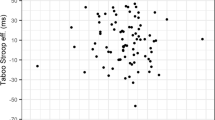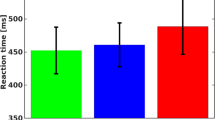Abstract
By combining the semantic Stroop paradigm (e.g., Klein in American Journal of Psychology 77:576–588, 1964) with a single-letter coloring (SLC) procedure (e.g., Besner et al. in Psychonomic Bulletin & Review 4:221–225, 1997), this research investigated whether the frequently reported Stroop-related event-related potential (ERP) effect arising about 400 ms after stimulus onset (Ninc) is sensitive to the semantic and/or the response conflict. Consistent with our past findings (e.g., Augustinova et al. in Psychonomic Bulletin & Review 17:827-833, 2010), SLC speeded up reaction times for standard-incongruent items only, indicating that SLC reduced the response conflict that these (but not color-associated and neutral) items involve. Ninc amplitudes were more negative for standard-incongruent and color-associated than for color-neutral items. Importantly, this difference was not modulated by SLC. Hence, the behavioral and ERP results conjointly suggest that the Stroop-related Ninc is sensitive to semantic rather than to response and/or general conflict.

Similar content being viewed by others
Notes
In order to designate the relative negativity associated with the incongruent items, as compared with the neutral ones, we opted for the label Ninc, since it is agnostic with regard to the exact timing (300–500 ms), topography, and functional characteristics of this Stroop-related effect.
Because color associates (SKY green) are displayed in a color that is different from the one they are associated with (i.e., sky with blue), this color—which is retrieved when the word dimension is read—subsequently conflicts with the meaning of the word’s color dimension (i.e., green for SKY green). But since color associates do not activate incorrect motor responses (e.g., say “blue”/press blue for SKY green ; e.g., Schmidt & Cheesman, 2005), their processing involves no response conflict.
The same analysis on error rates only revealed the effect of stimulus type, F(2, 54) = 12.48, p < .001, η p 2 = .32 (see Table 1).
Indeed, the direct analysis of magnitudes for both standard and semantic Stroop interference (observed at each level of coloring; see Table 1) revealed the expected orthogonal interaction, F(1, 27) = 9.07, p < .01, η p 2 = .25. Accordingly, its decomposition showed that the standard Stroop interference of 75 ms in ALC was reduced to 25 ms in SLC, F(1, 27) = 8.97, p < .01, η p 2 = .25, whereas semantic Stroop interference remained statistically equivalent in both the ALC and SLC conditions (17 and 10 ms, respectively), F(1, 27) = 0.38, p = .54, n.s.
It should be recalled that Ninc is a relative negativity resulting from the difference between incongruent and color-neutral items.
M SLC = –1.08, SE SLC = 0.39 versus M ACL = –0,77, SE ALC = 0.34.
The same reasoning actually applies to the use of standard-congruent items (BLUE blue) as a baseline, because such items elicit facilitation (i.e., qualitatively different phenomenon from interference that incongruent items involve; see, e.g., Brown, 2011), due, respectively, to semantic and response compatibility.
References
Appelbaum, L. G., Meyerhoff, K. L., & Woldorff, M. G. (2009). Priming and backward influences in the human brain: Processing interactions during the Stroop interference effect. Cerebral Cortex, 19, 2508–2521.
Augustinova, M., & Ferrand, L. (2007). First-letter coloring and the Stroop effect. L'Année Psychologique, 107, 163–179.
Augustinova, M., Flaudias, V., & Ferrand, L. (2010). Single-letter coloring and spatial cuing do not eliminate or reduce a semantic contribution to the Stroop effect. Psychonomic Bulletin & Review, 17, 827–833.
Augustinova, M., & Ferrand, L. (2014a). Social priming of dyslexia and reduction of the Stroop effect: What component of the Stroop effect is actually reduced? Cognition, 130, 442–454.
Augustinova, M., & Ferrand, L. (2014b). Automaticity of Word Reading: Evidence from the Semantic Stroop Paradigm. Current Directions in Psychological Science.
Besner, D., Stolz, J. A., & Boutilier, C. (1997). The Stroop effect and the myth of automaticity. Psychonomic Bulletin & Review, 4, 221–225.
Brown, T. L. (2011). The relationship between Stroop interference and facilitation effects: Statistical artifacts, baselines, and a reassessment. Journal of Experimental Psychology: Human Perception and Performance, 37, 85–99.
Coderre, E., Conklin, K., & van Heuven, W. J. (2011). Electrophysiological measures of conflict detection and resolution in the Stroop task. Brain research, 1413, 51–59.
Cohen, J. (1988). Statistical power analysis for behavioral science (2nd ed.). Hillsdale, NJ: Erlbaum.
Ferrand, L., & Augustinova, M. (2014). Differential effects of viewing positions on standard versus semantic Stroop interference. Psychonomic Bulletin & Review, 21, 425–431.
Hanslmayr, S., Pastötter, B., Bäuml, K. H., Gruber, S., Wimber, M., & Klimesch, W. (2008). The electrophysiological dynamics of interference during the Stroop task. Journal of Cognitive Neuroscience, 20, 215–225.
Killikelly, C., & Szűcs, D. (2013). Asymmetry in stimulus and response conflict processing across the adult lifespan: ERP and EMG evidence. Cortex, 49, 2888–2903.
Klein, G. S. (1964). Semantic power measured through the effect of words with color-naming. American Journal of Psychology, 77, 576–588.
Küper, K., & Heil, M. (2012). Attentional focus manipulations affect naming latencies of neutral but not incongruent Stroop trials. Swiss Journal of Psychology, 71, 93–100.
Kutas, M., & Federmeier, K. D. (2011). Thirty years and counting: Finding meaning in the N400 component of the event-related brain potential (ERP). Annual Review of Psychology, 62, 621–647.
Liotti, M., Woldorff, M. G., Perez, R., III, & Mayberg, H. S. (2000). An ERP study of the temporal course of the Stroop color-word interference effect. Neuropsychologia, 38, 701–711.
Manwell, L. A., Roberts, M. A., & Besner, D. (2004). Single letter coloring and spatial cueing eliminates a semantic contribution to the Stroop effect. Psychonomic Bulletin & Review, 11, 458–462.
Monahan, J. S. (2001). Coloring single Stroop elements: Reducing automaticity or slowing color processing? Journal of General Psychology, 128, 98–112.
Neely, J. H., & Kahan, T. (2001). Is semantic activation automatic? A critical re-evaluation. In H. L. Roediger III, J. S. Nairne, I. Neath, & A. M. Surprenant (Eds.), The nature of remembering: Essays in honor of Robert G. Crowder (pp. 69–93). Washington, DC: American Psychological Association.
Schmidt, J. R., & Cheesman, J. (2005). Dissociating stimulus-stimulus and response-response effects in the Stroop task. Canadian Journal of Experimental Psychology, 59, 132–138.
Stroop, J. R. (1935). Studies of interference in serial verbal reactions. Journal of Experimental Psychology, 18, 643–662.
Szűcs, D., & Soltész, F. (2010). Stimulus and response conflict in the color–word Stroop task: A combined electro-myography and event-related potential study. Brain Research, 1325, 63–76.
Acknowledgements
All the authors wish to thank Pierre Chausse for technical support and Derek Besner, Martin Heil, and one anonymous reviewer for their helpful advice, comments, and suggestions on previous drafts of the manuscript.
Author information
Authors and Affiliations
Corresponding author
Rights and permissions
About this article
Cite this article
Augustinova, M., Silvert, L., Ferrand, L. et al. Behavioral and electrophysiological investigation of semantic and response conflict in the Stroop task. Psychon Bull Rev 22, 543–549 (2015). https://doi.org/10.3758/s13423-014-0697-z
Published:
Issue Date:
DOI: https://doi.org/10.3758/s13423-014-0697-z




